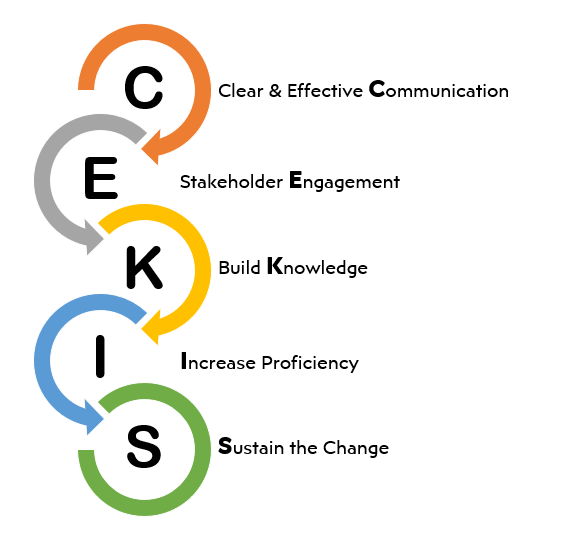Key Goals and Objectives of a Change Management Team
Everything You Need to Know for 2024
What Are the Goals of Change Management in 2024?
When a project impacts the way people do things, change management helps ensure those people successfully adopt the required changes. The people being impacted by the project are referred to as “stakeholders,” and they can be employees, vendors, customers, or another group.
To enable project success, change practitioners need to understand the overall objectives of change management. They also must define any change management objective specific to the project they’re supporting. The objectives drive the OCM plans and engagement.

What are the objectives of change management?
In order to be effective, change management activities need to be planned to meet the organizational change objectives. Ask yourself… What does project success look like? What systems, tools, or processes do stakeholders need to adopt? What barriers are in the way of achieving the change management vision for the project?
The main objective of change management is to enable the sustained adoption of the project solution so that the project can meet its projected ROI. Reaching that overall change management objective, takes several milestones along the way – these are guided by the supporting change management goals.
Below, we’ll review five goals of change management and explain why they’re important for the successful adoption of a project.
Do you have questions about the change management goal of project adoption or the foundational objectives of organisational change? Just reach out to the OCM Solution Team.
Table of Contents: 2024 Best Change Management Objectives
Keep on scrolling down this page to read each section or click any link below to go directly to that section.
- 5 Key Change Management Objectives
- How Do You Achieve the Objectives of Organizational Change?
- Clear and Effective Communication
- Stakeholder Engagement
- Build Knowledge
- Increase Proficiency
- Sustain the Change
- Questions? Need Change Mgt Consulting Help?
If you have any questions or feedback about this article on the main change management goals and and how to define your change management objectives, please let us know. Contact the OCM Solution Team.
5 Key Change Management Objectives
When organizational change management (OCM) teams implement change plans to help organizations transition through a change, they often focus on five key change management objectives to help achieve their goals for spreading awareness about the change, improving end-user acceptance of the change, increasing knowledge & proficiency, and reinforcing the change.
Reaching these goals is the focus of the change management vision for the project. These change management goals and objectives give direction to the engagement with stakeholders. They also provide a tangible metric to measure potential risk and success for the project.
The 5 change management objectives are as follows:
- Clear and Effective Communication: Spread awareness of the transformation program via a robust communication campaign. Communicate frequently and transparently.
- Stakeholder Engagement: Facilitate stakeholder engagements to educate business units on the level and magnitude of the change, and build their desire to support the change.
- Build Knowledge: Lead the development and execution of training programs to provide employees with the knowledge on how to change.
- Increase Proficiency: Facilitate coaching and business user testing of target state processes and procedures to enable new skills and end-user proficiency.
- Sustain the Change: Reinforce the change to ensure long-term sustenance. Track and measure process adoption, impacted user proficiency, and change readiness.

Read more: A Top Proven Change Management Framework.
In the next section, we are going to break down each change management objective and look at the typical activities change practitioners can do to achieve them.
If you have any questions or feedback about this article on the main objectives of planned change and how to define your change management goals, please let us know. Contact the OCM Solution Team.
How Do You Achieve the Objectives of Organizational Change?
For the change management objectives examples listed in the section above, what do you actually DO to reach them? I often get this question from my change management consulting clients. While each project is unique, there are key activities you can do to achieve the core goals of change management.
I’ll go through some helpful tips for each change management objective below that will provide insights to support your future change projects.
Clear and Effective Communication
This change management objective should be preceded by a change impacts assessment for the project. This not only informs you WHO to communicate with but also HOW and how much you need to communicate with them.
Highly impacted stakeholders will need more communications to ensure they have the information they need to successfully transition to the new way of doing things once the project goes live. Those not being impacted as much will need fewer communications.
One other type of assessment that can inform this change management goal is a readiness assessment, which lets you know where readiness gaps exist. You can address these gaps with appropriate communications. Such as targeting resistance with a communication focused on the benefits of the change for a particular group.
Stakeholder Engagement
Stakeholder engagement is one of the change management objectives that involves many different processes. These are driven by readiness gaps you find in readiness assessments and the project needs that you’ve assessed.
Activities for engaging with stakeholders are ongoing during your change enablement and through the post-go-live adoption phase, when you’re ensuring that the change objectives outlined at the beginning of the project are reaching fruition.
Some stakeholder engagement activities include:
- Meetings and briefings
- Resistance management
- Coaching & training
- Sending communications (like emails, internal messages, etc.)
- Working with a project change champion network
- Meeting with managers of impacted groups
- And more
Build Knowledge
People that are expected to adopt new changes need to not only have the knowledge to adopt them successfully, but they also need to feel confident in that knowledge. This change management objective is about using various tools to provide that knowledge and confidence.
Some of the ways that you can build knowledge to meet this change management goal are through coaching support, formal training, and reinforcement of knowledge through FAQs, office hours, help desk support, and internal project Wikis.
Increase Proficiency
Once your planned training is done, does that mean every stakeholder is proficient in the new process? Not really. To become proficient, people need to be given adequate training AND adequate time to practice the new process or other changes.
Reaching proficiency is one of the objectives of change management that can fall by the wayside if users aren’t properly supported after the project goes live in the organization. It’s after they are expected to use the new process in their daily workflow that stakeholders need the most support to become proficient at using it.
Sustain the Change
As a reminder, the main objective of change management is to ensure successful user adoption of the changes that a project requires. This means “sustained” adoption. You don’t want users to revert to the old way of doing things as soon as nobody is watching.
You can achieve this change management objective by ensuring that users have plenty of support after the project goes live. You also need to monitor for any new signs of resistance or roadblocks that stakeholders may be running into.
It’s crucial to provide plenty of help and support resources for at least 4-6 weeks after the project goes live so you can reach this important change management goal.
Questions? Need Change Mgt Consulting Help?
Send me a message if you have any questions or feedback about creating and achieving change objectives. In addition, if you need change management consulting help, don’t hesitate to review: Airiodion Group – A Specialized Change Management Consultancy.
Regards,
Ogbe Airiodion
Sr. Change Management Consultant
Image sources: Stock.adobe.com
Read more: A Top Proven Change Management Framework.
